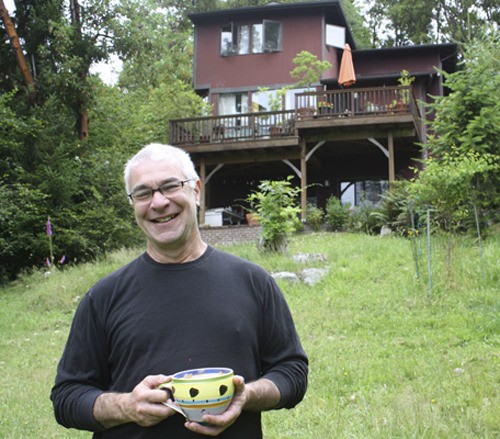Michael Rosenberg tried everything he could think of to lower his family’s electric bill. He swapped incandescent bulbs with compact fluorescents. He bought a new, more efficient hot water heater and a new refrigerator.
But energy usage in his 2,700-square-foot home near the Tahlequah ferry “always seemed to be going up,” said Rosenberg. In wintertime (December through March), he was paying more than $300 per month.
At first, Rosenberg suspected a faulty meter. But he had the meter tested — twice. No problem there. He figured his two teenage sons were being less than responsible about turning things off.
And then there was his partner, Francesca. She had set up an art studio in the basement and was probably using more electricity than she realized, especially since she liked to leave a space heater going for one of their older cats. Bottom line: It was time to get more aggressive about conserving energy.
Rosenberg and his family have lived on Vashon since 1983. They moved from Gold Beach to their current home in 2003. The three-story wood frame house sits on a concrete slab in the center of a five-acre lot with a view of the water. It has a daylight basement and electric baseboard heat.
“We’d been thinking about ways to reduce our energy usage and get greener,” said Rosenberg, who is a professional photographer. “I’d been thinking, ‘okay, my next step should be to insulate the attic better.’ We stopped by the WISEnergy kiosk. They gave us Greg Kruse’s name. He did an energy audit, which was very incredible in terms of the information it produced. His recommendation was that the attic didn’t need additional insulation. But we were finding huge areas of leakage around all the windows, light sockets, doors and the joists in the basement. So that’s what we focused on. Sealing up all the leaks.”
Kruse owns the new Vashon-based company Potential Energy and is a WISEnergy board member. He has performed energy audits on many Island homes.
Here’s how an energy audit works: He installs a “blower door” — basically a plastic door with a large fan in the center — on one of the house’s doors. Then he seals up all the heating vents and turns on the fan. The fan draws air out of the house, creating a kind of reverse draft. The air coming through during the energy audit is a direct measure of the heat flowing out.
In Rosenberg’s home, the breeze was pronounced.
“You could go around the house and literally feel the drafts,” said Rosenberg. “Who would think that a source of heat loss would be a light socket or a light switch or a light can in the ceiling? To realize how much draft was coming through them was remarkable. I had no idea.”
Kruse spent several days sealing every hole in Rosenberg’s house with foam, adding insulation behind all the light sockets, switches and cans, and weather-stripping doors. Because he was sealing the house so tightly, Kruse installed a fan in the upstairs bathroom to help increase airflow and prevent mold and mildew. Rosenberg then replaced a few double-pane windows whose seals had failed.
All in all, the work cost about $1,900. Rosenberg decided to hold off on the more expensive job of plugging the gaps in his basement where the house and foundation meet.
“That’ll be a project for next year,” he said. “At that point we should be sealed up pretty tight.” He won’t see the effect of all this weatherizing on his electric bill until next winter, but he’s “guessing it’ll be at least a 10 to 20 percent drop.”
In the meantime, Rosenberg has two words for anyone looking to cut their home energy usage: energy audit.
“It’s a really good place to start,” he said. ”I started out thinking I was going to insulate the roof, and it turned out what I really needed to do was insulate the light fixtures — which was a lot cheaper.”
— Mary Bruno is a
freelance writer.



